Oct 19, 2017 | coin design, coins, commemorative
NOTE: I reached out to LeRoy Transfield, the winner of the design competition for the World War I Centennial Commemorative dollar coin to ask about his experience with the design competition. He sent me a copy of his story with permission to publish it here. The following is what he sent. I had additional questions. Those will be published tomorrow.
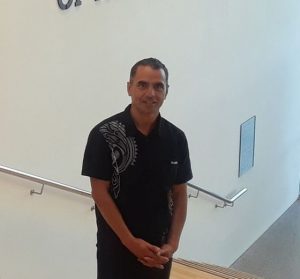
LeRoy Transfield
Secondly, I was excited because I am a sculptor and love sculpture of all kinds. My specialty is sculpture in the round, figures, people. I have done very few low relief sculptures and no coins. Despite this, I enjoy looking at well-sculpted coins and even have a small coin collection of my own. My favorite American coin is the Standing Liberty quarter by Hermon MacNeil.
Thirdly I have done a number of war memorials for local towns in the area including the city I live in. During these experiences, I have gotten to know many veterans and people that fought in most of the major wars of the 20th century. Many of them including people I worked very closely with are now gone. But I often think of them and how their lives have touched mine.
Last, I was inspired by my own family. Both extended and immediate. I have been supported and helped over the years and always feel grateful for their support. Also, my Great Uncle on my mother’s side actually fought in World War One as part of the Maori Battalion. The Maori Battalion were part of the New Zealand Expeditionary Force to aid the allies. The Maori are the indigenous people of New Zealand.
All this excitement and energy flowed through me when I first got the news that I was a finalist. I so wanted to create a great design! Even though I had seen many WW I movies already and new the history, I review many pictures, books, films and documentaries to focus on the American role in the war.
I also looked at great coins. Not so much as to get an idea for a design or copy them, but to dissect those good coins and figure out what made them so good compared to average coins and what rules helped them achieve such inspiring results. I wanted an original design but one that followed those lines of greatness.
I thought about the poem, In Flanders Fields and thought Poppies would be a good thing to put in there somewhere. I also thought of the armistice and how excited everyone was when the hour came. A peace that may well not have happened without American support.
With all these thoughts, I started drawing images. I drew for two weeks. Ideas and designs of mostly soldiers in different poses that could easily be accentuated in a relief coin design. After this I started making clay versions of my sketches and quickly realized the drawings were useless and didn’t help me see problems in the design once it was built up in clay.
After about 4 or 5 weeks I was hitting a wall. No really good design was standing out from the numerous changes and trials I had done. The mint offered a conference call to all 20 participants to go over any questions we might have. This was of great help. In the call, I asked, what is the most common mistake made by beginning coin designers. The person, I forgot his name, said the most common mistake was adding too much detail to the 8-inch mock-up because one has to keep in mind that the final will be only 1.5 inches and much of the detail will be lost. Even though I already knew this it sank in even more. The other impression I got from the call was that the mint is really leaving things open to the finalists and wants to see what we can come up with, and not worry a whole lot about whether the design is right for coining as they have sculptors would fix those problems. They just wanted to see what we could come up with.
The first thing I did was scrap the board I was working on. At 18 inches, it was way too big. I thought that in working larger than the required 8 inch casts to be submitted, I could make a good large design and boil it down to a really good 8-inch final. Instead, I went the opposite way and started to work smaller than the 8 inches to get a better feeling of a coin. I started sculpting on 4-inch wood discs. This really helped a lot. It made it way easier to make a quick design and
help me see if it was going to work. I finally came up with the soldier profile, collar up and a rifle slung over his shoulder. This was not the final design but a good starting point. As I had the soldier in profile worked up, I wanted to add to it but knew not what it needed. That night I had barbed wire going through my head. Soldiers charging barbed wire, wire in the dirt and finally somehow, wire on my relief sculpture. After dreaming about barbed wire, I went to the piece and add the two small strands of wire in opposition to the rifle and the soldier. The hands also seem a natural thing to add and just like that I had the design for the Obverse.
I was very demanding on myself and didn’t say, that’s it, that’s the one. What I said was that’s a good Obverse, now make another. Another one never came. I was running out of time so I decided then to make that my Obverse and put my thoughts into the reverse. I actually thought I had a good idea already, an eagle. It was going to be a diving eagle, in profile, with wings outstretched holding arrows and an olive branch. In the eagle’s beak would be a banner with the words e plurubus unum. In the background would be a map of Europe. I just knew it would look good. But when I fleshed it out it looked terrible!
I looked for another idea. It had to be as good as the soldier. The eagle didn’t work but I wanted to try a bird again and knew that carrier pigeons were used a lot in World War One so I decided to use a pigeon. I looked at many pigeons and pigeon photos and sculpted up something I thought looked ideal. This was good because the time for submitting was running out! I had only three days left.
With the pieces molded and cast to the 8 inch specifications I had the two designs. The soldier looked good. I had different thoughts about the pigeon. I sculpted the bird as best I could but the final reverse looked not near as good as the obverse. I was dumbfounded. I had to send the pigeon, time was up, I had no time to make another. But as I looked at the pigeon I became more and more alarmed to the point where my stomach ached to look at it. I was tired of the whole project.
I thought I should just send it and be done with it. But on more reflection, I just couldn’t do it, I couldn’t send it!
Firstly, I thought of the embarrassment of the committee seeing this lousy pigeon. I wouldn’t be there, I reasoned, but that didn’t help. Sure, they might like the soldier, perhaps they will choose that and another reverse. Even so I just couldn’t send it. So, I did a thought conversation and said to myself if you don’t like it they make something else, in your style, that you do like. Even if the committee doesn’t like it at least you can be happy with what you send and no regrets. But then I would vacillate back to you have run out of time just send it and be done with the thing.
At that time, my daughter wanted to go on a 9-mile bike ride up Provo Canyon, a favorite summer activity and jump off a local bridge into the chilling Provo river. School was about to start so this would be one last activity with my daughter. The ride there took about an hour. In retrospect, this time away made all the difference in my final decision to send a different reverse. As I left and rode away from my work I had a greater perspective. I could see I had learnt a lot in the last 10 weeks about coin sculpting and may well be able to come up with a good design in two days. Halfway into my ride I convinced myself that the pigeon had to go and now, what was I going to do to replace it? As we got to the bridge I came back to the beginning, poppies. But poppies are a little uninteresting and not that good looking in relief coin sculpture. So, my next thoughts were how to make the poppies look better.
This was all going on while I was enjoying the summer weather and river water with my daughter. To jump into the river, one would climb up on a steel rail about 4.5 feet above the bridge, balance there and jump into the water 15 feet below. It was exhilarating. Standing on top of the rail is quite an inspiring thing. The beautiful canyon, trees, rocks, and water looked awesome. I often thought that on a stormy day a bolt of lightning could easily find its way to the person standing perched so high on the bridge. As I stood there I thought came to me of using the barbed wire again in contrast to the poppies. I’ve got it I said and jumped into water fridge water. I had it all now, in my mind.
All I needed to do was go home and put in down in clay. When I got home my wife to catch up with me on her day. We talked about the recent passing of my old sculpture teacher and some of the funny stories he would tell us students. All this time I was sculpting the poppies and the wire. In an hour, it was done. That’s it! I said. I was unsure if it was a winning design but it was a design I could put my name to and come what may, I wasn’t embarrassed.
The plaster casts made it to the US mint the very last day of the deadline.
Portrait of the LeRoy Transfield taken from the artist’s
website.
Oct 11, 2017 | celebration, coin design, coins, commemorative, US Mint
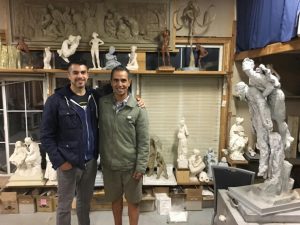
Utah sculptor LeRoy Transfield, right, poses in his sculpting studio in Orem.
The winning design was submitted by LeRoy Transfield, a sculptor from Orem, Utah.
In an interview that appeared in the Desert News, Transfield said that he had two uncles that served as members of the New Zealand Expeditionary Force Native Contingent during World War I. This lead to his interest in learning about the history of the war.
-

-
2018 World War I Centennial Silver Dollar Obverse — “Soldier’s Charge” by LeRoy Transfield
-

-
2018 World War I Centennial Silver Dollar Reverse — “Poppies in the Wire” by LeRoy Transfield
For the obverse, Transfield titled it “Soldier’s Charge.” In the interview, Transfield said that he “didn’t want him to look like some model in an artist’s studio. I made his nose like it might’ve been broken. I wanted to give him a rugged looking face. … I wanted that feeling of combat”
Transfield said that the reverse was more difficult to for him to design. After several tried he came up with the “Poppies in the Wire”
In 2012,
I wrote about the poem “In Flanders Fields” and suggested that it be adopted on a U.S. commemorative coin. It only took five years for my suggestion to become a reality! You can read about the poem and my recommendation
→ here.
Poppies are a fitting tribute since their use was inspired by the poem “In Flanders Fields.” The poem was written by Lt. Col. John McCrae, a Canadian physician following the funeral of a friend and fellow soldier who died in battle. It was published in 1915 and first adopted by the American Legion to commemorate the American Soldiers killed in the war. It was later adopted by veterans groups within the British Empire including Canada.
Transfield is originally from New Zealand but moved to the United States to attend BYU-Hawaii. After graduating with a Bachelors of Fine Arts degree, he moved with his wife to Orem where he operates a sculpting studio in his garage.
Based on the line drawing, it appears that this is going to be an excellent design when struck on a 40mm silver planchet. This is one time where it appears that the Citizens Coinage Advisory Committee and the U.S. Commission of Fine Arts got it right in picking the design.
The World War I American Veterans Centennial Commemorative Coin will be issued in 2018. According to the law (Public Law 113-212) , the U.S. Mint is limited to selling no more than 350,000 silver dollars. Each coin will have a $10 surcharge (a maximum of $3.5 million) will be paid to the U.S. Foundation for the Commemoration of the World Wars to assist the World War I Centennial Commission in commemorating the centenary of World War I.
Given the texture in the both the soldier on the front and the poppies on the reverse, it will be interesting to see if the U.S. Mint comes up with an enhanced uncirculated version. It could be extraordinary!
Credits
- Image of LeRoy Transfield in his studio courtesy of the Desert News.
- Coin line art images courtesy of the U.S. Mint.
Mar 19, 2017 | cents, coin design, coins, errors, US Mint
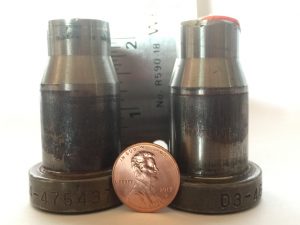
Lincoln Cent Dies from the Denver Mint
Dies from the U.S. Mint makes for an interesting collectible. Standing about 2½ inches tall and about 1¼ inches across the base where it is loaded into the coining press, it is really an unremarkable piece of metal. Weighing 192 grams (about 6.8 ounces), the only distinguishing marks on the die is the serial number stamped on the base.
Before being discarded, workers at the U.S. Mint are supposed to completely grind off the design so that it cannot be used to strike counterfeit coins. Even though it is not cost effective to flood the U.S. economy with counterfeit Lincoln cents, the U.S. Mint does not want to take the chance someone will try. Once the design is removed from the die it can become a collectible.
Close-up images of the dies make the visible design look more dramatic than in person. After all, the images were likely taken with a macro lens on a die used to strike a coin 19.05 mm (0.750 inches) in diameter. Even so, the idea was fascinating enough for me to submit bids high enough to win both dies.
The first “error” die was used to strike the obverse of 1993-D Lincoln cents. This die is not completely filed down since it does show some of Lincoln’s hair. Although not a large area, there is enough of the incuse portion of the die’s section to be able to identify it as hair and providing a good guess as to where it would be on the coin. The sticker in the image was placed there by the seller. I decided to leave the sticker.
-
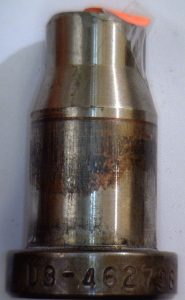
-
View of the 1993-D Lincoln Cent obverse die
-
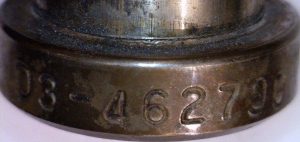
-
Serial number for the 1993-D Lincoln Cent obverse die shows the D for Denver, 3 for 1993, and followed by a sequence number
-
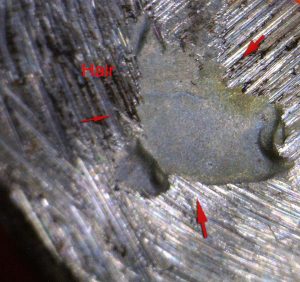
-
Close up of the 1993-D Lincoln cent die showing part of the hair design still visible.
The other error die was used to strike the reverse of 1994-D Lincoln cents. In this case, the “error” is very subtle. There are two lines that would have been where the bottom two steps of the Lincoln Memorial would have been. Based on the placement, these would be to the center-right of the Lincoln statue in the monument. In the image, it is at the bottom of the “R.” I do not know why the “CR” is written on the die but I am not removing it, for now.
-
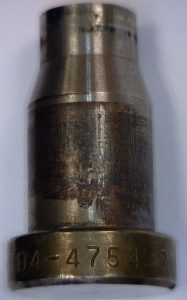
-
View of the 1994-D Lincoln Cent reverse die
-
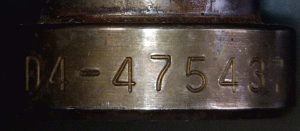
-
Serial number for the 1994-D Lincoln Cent reverse die shows the D for Denver, 4 for 1994, and followed by a sequence number
-

-
Close up of the 1994-D Lincoln cent reverse die showing a small section of the steps to the Lincoln Memorial still visible
I do not know how Fred Weinberg finds these items but they are fascinating. The next time you go to a show you should check out his inventory. He finds some really interesting errors that have to be seen to be believed.
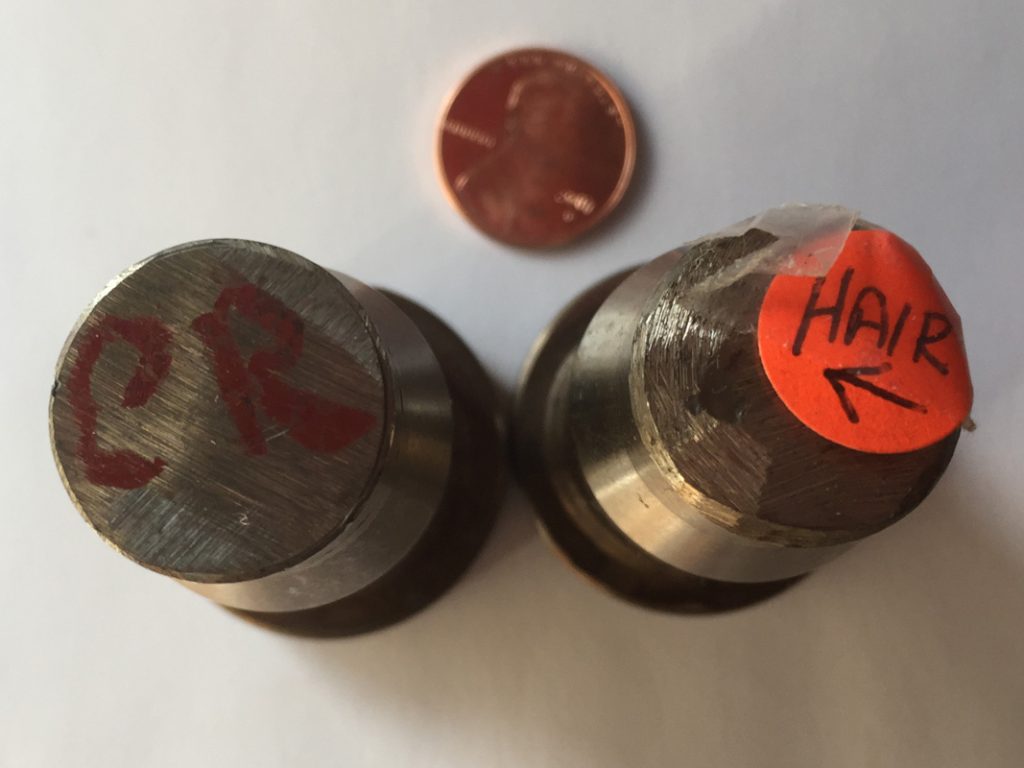
Looking down on the Lincoln Cent “error” dies. The 1994-D reverse die is on the left, The 1993-D obverse die is on the right.
Nov 20, 2016 | bullion, coin design, coins, gold, US Mint
In 1916, the U.S. Mint began to circulate three iconic coin designs that remain favorites amongst collectors. To celebrate, the U.S. Mint issued 24-karat gold centennial versions of the Mercury Dime, Standing Liberty Quarter, and Walking Liberty Half-Dollar. The designs of the coins are the same as their century-old counterparts except the gold specification was added. Earlier this month, the U.S. Mint released the 2016-W Walking Liberty Half-Dollar 24-karat gold coin to complete the series.
-
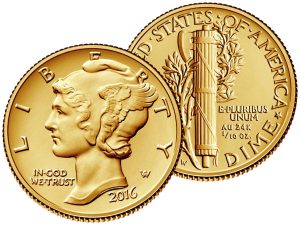
-
2016-W Mercury Centennial Gold Dime
-
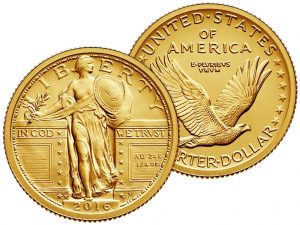
-
2016-W Standing Liberty Centennial Gold Quarter
-
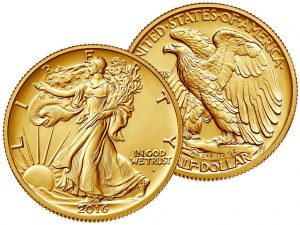
-
2016-W Walking Liberty Centennial Gold Half-Dollar
With the release of the gold Walking Liberty Half-Dollar, every coin design that was part of President Theodore Roosevelt’s “pet crime” that has gone out of circulation, except the Bela Lyon Pratt quarter and half-eagles and the Saint-Gaudens $10 eagle, have been reproduced at least once. Only Victor D. Brenner’s Lincoln Head Cent design remains in circulation even though the reverse has been redesigned a few times.
Isn’t it time we move on?
Let’s forget the legal limitations placed on the U.S. Mint that only allows them to do a tribute like this in gold even though the original coins were struck in silver, how many collectors are really interested in buying these coins? How many can afford these coins?
Judging by the listings for online auctions and dealers that specialize in modern precious metals, it seems that the alleged sellout of the gold Mercury Dime was because of speculation. While there will always be some opportunists in any market, the appearance of the churn in that market feels more like people looking to make money rather than collect, especially since its $209 issue price is more affordable.
Now, both the Standing Liberty and Walking Liberty gold coins are still available. With the limited availability, why aren’t collectors buying these coins?
Aside from the cost of a gold coin, how many younger collectors or even those that are a part of Generation X have any connection to those coins? It is possible we Baby Boomers have seen these coins in circulation, even sparingly. I was able to find Mercury dimes and Buffalo nickels as late as the very early 1970s before they were all removed from circulation. My interest in collecting started when I found Indian Head cents in pocket change.
I am not saying that these designs are unworthy of a tribute. As a collective, they are arguably the most iconic designs of U.S. coinage. But what many consider the best of the best will live on as part of the American Eagle, Buffalo 24-karat, and the soon-to-be palladium bullion programs.
Isn’t it time we move on?
-

-
American Silver Eagle Proof
-

-
2009 Ultra High Relief Double Eagle Gold Coin
-
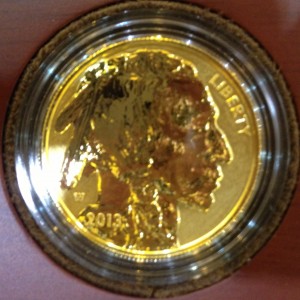
-
2013-W American Buffalo gold reverse proof obverse
Sales of mint and proof sets are down. Sales of commemorative coins are not meeting expectations where only a few have been sellouts. And the only modern coin that has seen any respect from the Baby Boomer and older collecting community was the 2014 50th Anniversary Kennedy Half Dollar gold coin.
It is time we move on.
The 115th congress will be sworn into office on January 3, 2017. Giving the congress time to get settled including my representative who will be entering his first term in the House, I will write to him to propose a that a silver program similar to the 24-karat gold program be created. Maybe, if coins are offered in silver, a more affordable metal, we can use those coins to generate additional interest in collecting.
It may not be much, but it is a start!
Coin images courtesy of the U.S. Mint.
Aug 8, 2016 | coin design, coins, commemorative, legislative, US Mint
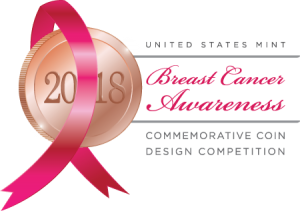 Thanks to congressional lawmaking, the U.S. Mint is holding competition for the two commemorative coin programs that will be issued in 2018. Earlier this year, the competition was opened for designs of the 2018 World War I Centennial Commemorative silver dollar. Now, the U.S. Mint has begun a competition for the 2018 Breast Cancer Awareness Commemorative Coins.
Thanks to congressional lawmaking, the U.S. Mint is holding competition for the two commemorative coin programs that will be issued in 2018. Earlier this year, the competition was opened for designs of the 2018 World War I Centennial Commemorative silver dollar. Now, the U.S. Mint has begun a competition for the 2018 Breast Cancer Awareness Commemorative Coins.
Signed into law on April 20, 2016 by President Obama (Public Law 114-148), the law requires the U.S. Mint to have an “juried competition” for a design “emblematic of the fight against breast cancer.” As part of the design, the law says that “The Secretary shall encourage three-dimensional designs to be submitted as part of the proposals.”
There is a caveat: you have to be an artist of some type and a U.S. citizen 18 years of age or older. You can read the Official Rules on the U.S. Mint website, but in summary Phase I of the competition is the evaluation of three-to-five examples of your work submitted digitally to the U.S. Mint. You have to be able to submit a digital portfolio. Even if your work is good and you think you can be part of the competition, you either have to be able to take a good picture of your work or find a photographer who can help.
An “expert” will review the submissions and select no more than 20 artists for the second phase.
In Phase II, those selected artists will be asked to submit one design along with a plaster model of both the obverse and reverse for the proposed coin that includes all of the necessary elements required of a coin. Only one artist’s design will be selected. The winning artist will receive “not less than $5,000.” If your design is selected, you will have your name etched in numismatic lore for being the designer of the coin. For this, your initials will appear on the coin, the Certificate of Authenticity, and in places like the Red Book!
Full details can be found on the U.S. Mint website.
Summary of the Breast Cancer Awareness Commemorative Coin Program
- Commemorative coins issued in 2018
- Design, emblematic of the fight against breast cancer, selected from a juried competition with no less than $5,000 going to winning design
- “The Secretary shall encourage three-dimensional designs to be submitted as part of the proposals”
- 50,000 $5 “pink gold” coins with an alloy of at least 75-percent gold with a $35 surcharge
- 400,000 one-ounce silver dollars made with not less than 90-percent silver with a $10 surcharge
- 750,000 clad half-dollar coins with a $5 surcharge
- Surcharges will be distributed to the Breast Cancer Research Foundation of New York, to further breast cancer research funded by the Foundation.
Pink gold can has been more commonly described as “rose gold.” Rose gold is an alloy of 75-percent gold with 20-percent copper and 5-percent silver. The color can be adjusted by changing the ratio of copper and silver.
Jun 17, 2016 | CCAC, CFA, coin design, coins, history, national park quarters
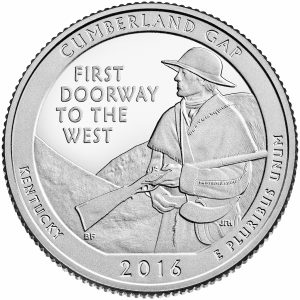
Revere of the 2016 Cumberland Gap Quarter
The artistic error was found by a member of my local coin club who also participates in re-enactments from the Revolutionary War era. Since he is acquainted with the how items from that period look, he told fellow club members about his find.
While looking at the quarter celebrating the Cumberland Gap National Historical Park in Kentucky he noticed something was wrong. A careful examination of the gun shows the flintlock is mounted on the wrong side.
During that time, since most people were right-handed or learned to shoot with their right hand on the trigger, the flintlocks were placed on the right side of the stock. Doing so allowed the flash created by striking the flint to be guided away from the shooter. If the flintlock was placed on the left, the flash would fire into the shooter causing injury.
Manufacturing technology was very different prior to the industrial revolution. Parts were either case manually with molds or formed one at a time where speed was important, especially to satisfy a government’s order to arm soldiers. It would be impractical to alter the basic mechanism for the majority of guns made. Left-handed guns were custom projects that only the wealthy could afford. A frontiersman would not be the type with the means to purchase a custom made gun with a left-handed flintlock.
-

-
Closeup on the backwards flintlock on the Cumberland Gap Quarter
-
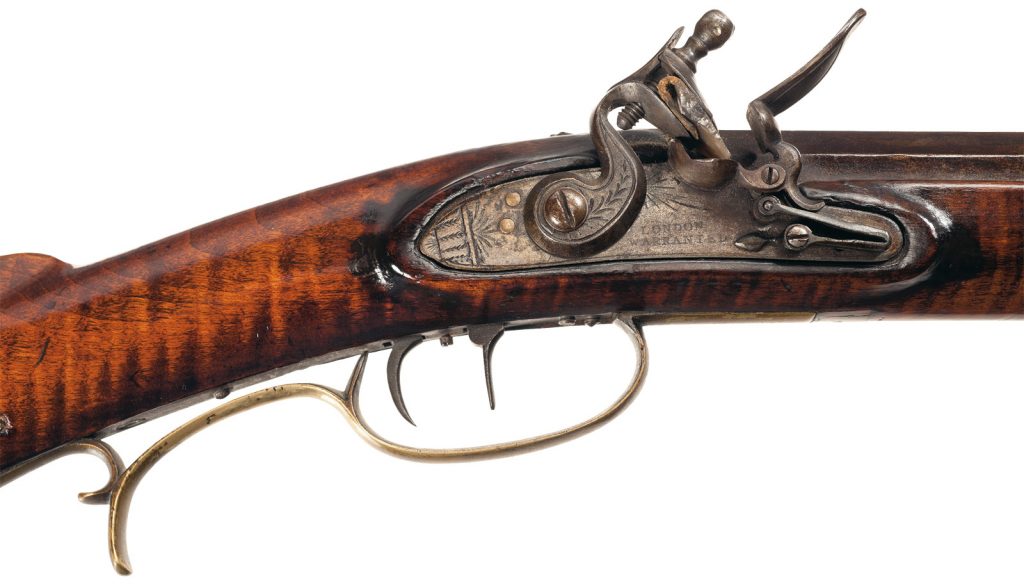
-
Closeup on the flintlock of an M. Martin Flintlock Kentucky Rifle
Further, look how the frontiersman is holding the gun. He is not cradling the gun with the trigger nearby so that he can fire if necessary. The butt, or stock of the gun is extended forward and the barrel pointed backward. Someone suggested that the perspective on the flat coin may make this look different but think about it, how would you hold the gun if you were standing on a ridge looking westward over an untamed landscape?
Although I did not have the eye or knowledge to pick up on this mistake, surely one of the specialists on the CCAC especially the one appointed to the commission who is a specialist in American history. I do not expect much out of the CFA since their specialties are not really fine arts since the majority of their work deals with the aesthetics of buildings, facades, and fencing around the District of Columbia.
There are 11 members of the CCAC and seven in the CFA and not one of them noticed any problems with this image? If they are allowing historically inaccurate images on United States coinage, then what is their purpose?
Apr 15, 2016 | bullion, coin design, coins, gold, US Mint
If you read my Baltimore show report, you might have noticed that I included images of the Mercury Dime 2016 Centennial Gold Coin. According to the U.S. Mint, the coin is scheduled to go on sale on April 21, 2016 at noon Eastern Time.
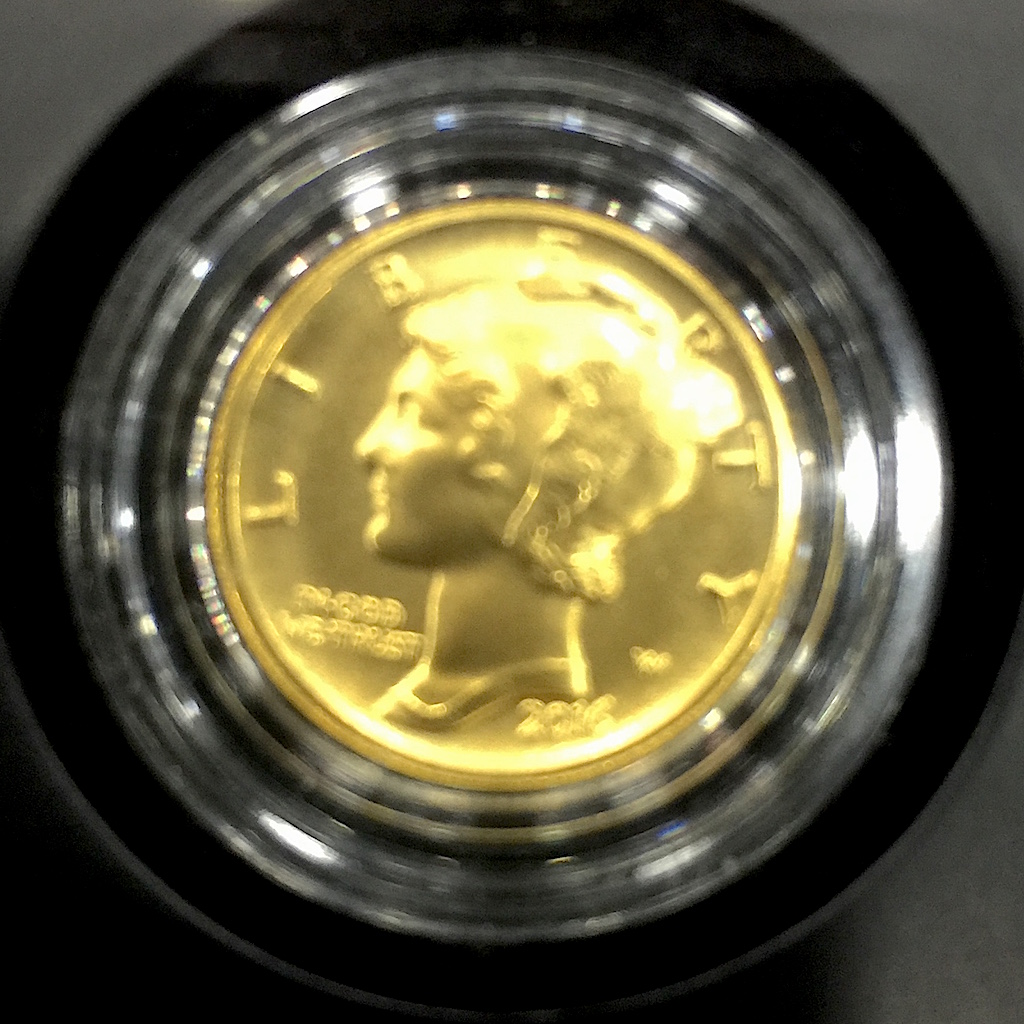
Obverse of the soon to be released Mercury Dime 2016 Centennial Gold Coin

Reverse of the soon to be released Mercury Dime 2016 Centennial Gold Coin
With a mintage limit of 125,000 and struck in West Point, the coin will be struck on a 24-karat (.999 pure) gold planchet. It will differ from the original Mercury Dime in that it will be dated 2016. On the reverse the coin will have the “W” mintmark since it will be struck in West Point, include “AU 24K” and “1/10 OZ.” to note that the coin will contain one-tenth ounce of gold. Otherwise, it looks exactly like Adolph A. Weinman’s design that was used from 1916 through 1945.
At 16.50 mm in diameter, the gold coin will be a little smaller than the 17.91 mm silver dime. The gold coin will be heavier (3.11 g) than the original that was made from 90-percent silver (0.7234 troy ounces).
To make this coin, the U.S. Mint is exploiting a loophole in the law that authorized the American Buffalo 24-Karat Bullion Gold Coins program (31 U.S.C. § 5112(q)). According to the law, after the first year of issue (2007), the Secretary can change the design of the coin as long as the design is reviewed by the Commission of Fine Arts and Citizens Coinage Advisory Committee. The U.S. Mint used this law to authorize the 2009 Ultra High Relief coin and the fifty year celebration of the Kennedy half dollar in 2014 with the dual date.
The original Winged Liberty “ Mercury” Dime was a silver coin produced as a result President Theodore Roosevelt’s “pet crime” where he thought U.S. coin design was hideous. Weinman was Augustus Saint-Gaudens’ student who is credited with finishing the work on Saint-Gaudens coin designs after the master sculpture’s death. It was not one of Weinman’s favorite works but it is beloved by collectors.
As a collector who has an almost complete collection of Mercury dime (missing the 1916-D), I was skeptical about the visual appeal of the coin in gold. When I open the folder, I see 30 years of silver coins. Since I try to keep my collection at extra fine (XF) or better, you can get used to seeing that beautiful silver color. When I saw the gold coin in a size that is close to the original dime in the presentation box at the Whitman Expo, I thought it made for a beautiful tribute.
Pricing of the coin will depend on the London Bullion Market Association (LBMA) afternoon price of gold on Wednesday, April 20. That number will be plugged into their pricing grid to determine the opening price of the coin. For example, the LBMA PM price of gold on April 14 is $1,233.85 per troy ounce. If this was the basis of the opening price, we would look up in the table for the price range $1,200.00 to $1,249.99. Since this is an uncirculated business strike coin struck under the American Buffalo act, the table shows that the coin would open at $194.00.
Using my example, this would give the coin a $70.61 or 36-percent numismatic premium over the spot price, which also takes into account U.S. Mint production costs (materials, labor, packaging, etc.).
If the LBMA PM price goes over $1,250 then the opening price of the coin will be $199.00. Being under $200.00 may give the market a psychological boost that may promote quicker sales. Then again, if the price of gold dips below $1,200.00, the coin will open at $189.00.
Putting on my prognosticator’s hat, I predict that the price of gold will go up enough that the opening price will be $199.00.
NOTE: I am just a blogger making a prediction. If you want a better market analysis, ask a professional advisor. They may have a more informed opinion, but we are all just throwing ideas up against the wall trying to figure out what will stick!
Jul 21, 2015 | coin design, coins, commemorative, commentary, dollar, gold, US Mint
What is going on at the U.S. Mint? For an organization whose actions are micromanaged by law seems to be finding a way to get around those rules to make some real questionable decisions.
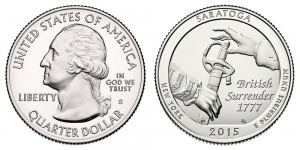
2015-S Saratoga National Historical Park Quarter
Just before the release of the S-mint quarters, the U.S. Mint changed its branding and changed the design of the Presidential $1 Coin Cover. Those of us who collect the coin covers now have two different formatted designs that shows when you show your 2010 Abraham Lincoln cover followed by the 2011 Andrew Johnson cover. And the change puts a thick black bar across the bottom forcing the portrait to be reduced making it an ugly design.
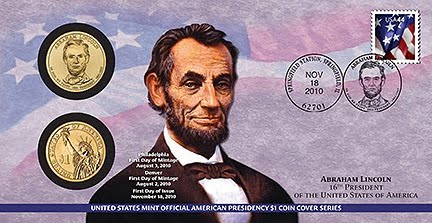
2010 Lincoln First Day Cover (before branding)

2011 Andrew Johnson First Day Cover (after branding)
Although I love the reverse proof coins and do not think including them in special sets, such as the 2015 Reverse Proof Roosevelt Dime as part of the 2015 March of Dimes Special Silver Set, but there are persistent rumors of a Presidential dollar reverse proof set. Why add a reverse proof set in the middle of a series? What is the U.S. Mint thinking? Adding a reverse proof to an existing series is as wrong as the S-mint national parks quarters.
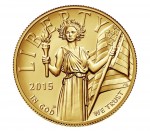
2015 American Liberty High Relief Gold Coin
Look at some of the past images of Liberty and they have a stronger look. Two of the most famous by Augustus Saint-Gaudens and Adolph A. Weinman has a striding Liberty that shows character. George Morgan’s Liberty had a regal look and Anthony de Francisi’s Liberty on the Peace dollar is just a marvel of beauty. This image is so uninspiring that I would buy the coin only because it is the first year of issue and has some investment potential. Otherwise, if I were to invest in 24-karat gold coins I would continue to buy the American Gold Buffalo.
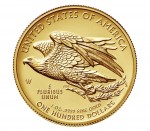
2015 American Liberty High Relief Gold Coin Reverse
I know that the designs were approved by the Citizens Coinage Advisory Committee and the U.S. Commission of Fine Arts. But, as usual, their motivations and sense of design is really in question. Maybe it is time we drop one of these committees and streamline the process.
Expanding collecting options from the U.S. Mint is good for the hobby. However, adding options to existing series and ugly coins should be discouraged.
Saratoga Park quater image courtesy of
USACoinBook.comAll other images courtesy of the U.S. Mint.
Apr 17, 2015 | BEP, coin design, currency, dollar, Federal Reserve, news
 During the course of searching for information, I stumbled upon the website for Women on 20s. It is a site dedicated to replacing the image of President Andrew Jackson with a woman by 2020. The group has targeted the $20 Federal Reserve Note to be replaced 2020 because it is the 100th anniversary of the passage of the 19th Amendment that granted women the right to vote.
During the course of searching for information, I stumbled upon the website for Women on 20s. It is a site dedicated to replacing the image of President Andrew Jackson with a woman by 2020. The group has targeted the $20 Federal Reserve Note to be replaced 2020 because it is the 100th anniversary of the passage of the 19th Amendment that granted women the right to vote.
Jackson is being targeted because as we look back through the long lens of history, he was not exactly a model person judging by today’s standards. During the War of 1812, Jackson led U.S. Army troops against native tribes working with the British against the United States to regain the lands taken following the colonies’ independence. It was said that Jackson’s troops were brutal against the native tribes on his orders, killing them rather than taking prisoners.
After beating back the British in the Battle of New Orleans, Jackson declared martial law in New Orleans and used his troops to enforce martial law. Aside from having a magistrate arrested who sided with a newspaper reporter writing who was arrested for writing negatively about his rule, he had members of the local militia who sided with the British executed without trial and went on to use it as propaganda to allegedly maintain order.
As president, Jackson’s policies to relocated native tribes lead to the Indian Removal Act that codified his policies. This lead to the “Trail of Tears” that forced the relocation of Cherokee, Muscogee, Seminole, Chickasaw, and Choctaw nations from their ancestral homelands in the southeast to an area west of the Mississippi River that had been designated as Indian Territory. It is considered the most violent and brutal act against the native tribes in United States history.
To have Jackson’s portrait on the United States central banks’ currency is also a bit ironic. Jackson was against the concept of a central bank and refused to renew the charter of the Second Bank of the United States and vetoed the bill to continue its charter. After winning election in 1833, Jackson withdrew all of the country’s funds from the bank limiting the bank’s ability to conduct business. He gave power to local banks to lend money and issued the Specie Circular, an executive order requiring government transaction be done in gold and silver coin (specie).
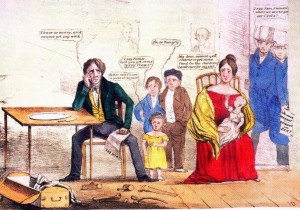
Poster issued by the Whig Party blaming Jackson for the Panic of 1837
The Women on 20s organization does not believe that this should be the legacy honored on U.S. currency. But if we look into the history of all of the men on U.S. currency, there are aspects of their pasts and personal lives that would make some blush, including Benjamin Franklin’s common law wife and illegitimate son.
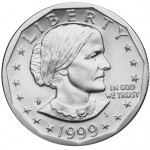 Women on 20s do recognize that suffragette Susan B. Anthony did appear on a one dollar coin but the coin failed because of its confusion with the quarter. They also recognize that Sacagawea, the Shoshone guide to Meriwether Lewis and William Clark, appears on the current one-dollar coin. Aside from the 2003 Alabama State Quarter, no other woman has appeared on circulating coinage (they do not count commemorative issues). Since neither dollar coin has circulated well and since the Alabama quarter was a temporary issue, the organization believes a better tribute is warranted.
Women on 20s do recognize that suffragette Susan B. Anthony did appear on a one dollar coin but the coin failed because of its confusion with the quarter. They also recognize that Sacagawea, the Shoshone guide to Meriwether Lewis and William Clark, appears on the current one-dollar coin. Aside from the 2003 Alabama State Quarter, no other woman has appeared on circulating coinage (they do not count commemorative issues). Since neither dollar coin has circulated well and since the Alabama quarter was a temporary issue, the organization believes a better tribute is warranted.
In what looks like an addendum to their argument, they mention that a portrait of Martha Washington appeared on the Series 1886 (Fr. #215) and 1891 (Fr. # 223) $1 Silver Certificates. Both Martha and George Washington appeared on the reverse of $1 Series 1896 Educational Series note (Fr. #224).
To decide who they will try to lobby to appear on the $20 note, the organization started with 15 candidates. Voters were asked to select thee of the 15 candidates in this preliminary round. The top vote-getters will be subject to another final voting round.

2012 First Spouse coin featuring Alice Paul
Women on 20s reported that 256,659 people had cast ballots when the first round ended on April 5, 2015. They reported that Eleanor Roosevelt, Harriet Tubman and Rosa Parks were named by as many as half of the voters as one of their top three. They added Wilma Mankiller to the final ballot. Mankiller, the first female Chief of the Cherokee Nation and the first female to be a chief of a native nation, was added because of a claimed “strong public sentiment that people should have the choice of a Native American to replace Andrew Jackson.”
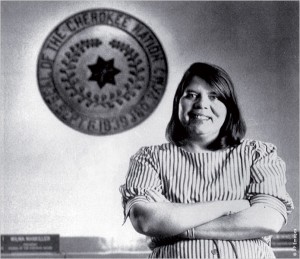
Wilma Mankiller, the first female principal chief of the Cherokee Nation
Voting is open at the time this is being written. There is no closing date listed on their website.
Since congress does not control the design of the currency, Women on 20s will have to convince the Federal Reserve to change the design of the $20 Federal Reserve Note. If the Federal Reserve, whose chair is Janet Yellen, agrees to the change, they will work with the Bureau of Engraving and Printing for the design and the U.S. Secret Service to ensure that the appropriate anti-counterfeiting measures are included.
Design changes to any Federal Reserve Note can take 3-5 years to complete.
NOTE: I contacted the Women on 20s organization for comments via email. That email has not been returned at the time of writing this article. If they answer my questions, I will publish them in a follow up post.
Image of the $20 FRN and Whig Party poster courtesy of Wikimedia Commons.
Coin images courtesy of the U.S. Mint
Image of Wilma Mankiller courtesy of the
Native American Encyclopedia.
Apr 10, 2015 | cents, coin design, coins, economy, news, US Mint
 The U.S. Mint has sent out a press alert saying that CBS Sunday Morning will air two segments this Sunday, April 12th, that may be of interest to collectors. The first segment will focus on the artists and engravers in Philadelphia and the role they play in the coin-making process. The segment will also look at some of the Philadelphia Mint’s history.
The U.S. Mint has sent out a press alert saying that CBS Sunday Morning will air two segments this Sunday, April 12th, that may be of interest to collectors. The first segment will focus on the artists and engravers in Philadelphia and the role they play in the coin-making process. The segment will also look at some of the Philadelphia Mint’s history.
A second segment will look at the penny and the debate about whether or not it should be eliminated.

Anthony Mason
CBS Sunday Morning is usually hosted by Charles Osgood and airs at 9 am Eastern Time. Check your local listings to see when it airs in your region.




























 During the course of searching for information, I stumbled upon the website for
During the course of searching for information, I stumbled upon the website for 





